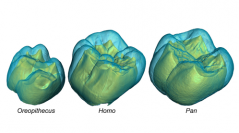

 Comptes Rendus Palevol
15 (1-2) - Pages 209-226
Comptes Rendus Palevol
15 (1-2) - Pages 209-226Oreopithecus bambolii, a large-bodied fossil ape, lived in the Tusco-Sardinian archipelago during the Late Miocene, until ca. 6.7 Ma. Its dentition, an apparent blend of hominoid and cercopithecoid-like features, has been a matter of discussion since its first description, in 1872. While the height and sharpness of its molar cusps recall some Cercopithecidae, Oreopithecus is currently considered by many as more likely related to dryopithecines. Here, we use microtomographic-based quantitative imaging and histological evidence to link outer and inner tooth structural morphology with enamel development in Oreopithecus permanent teeth. The material consists of 14 teeth/crowns from the sites of Baccinello and Casteani, in Tuscany, and Fiume Santo, in Sardinia. In particular, we add to the record of 2–3D of molar enamel thickness topographic variation and enamel-dentine junction morphology, and using high-resolution replicas of the outer crown and ground sections, comparatively assess molar growth trajectory (crown formation times and enamel extension rates). Our results shed new light on dental development of this “enigmatic anthropoid” and provide additional evidence concerning the still debated question of its evolutionary history.
Oreopithecus bambolii, Late Miocene, Dental structure, Virtual paleodontology, Tooth histology, Life history traits